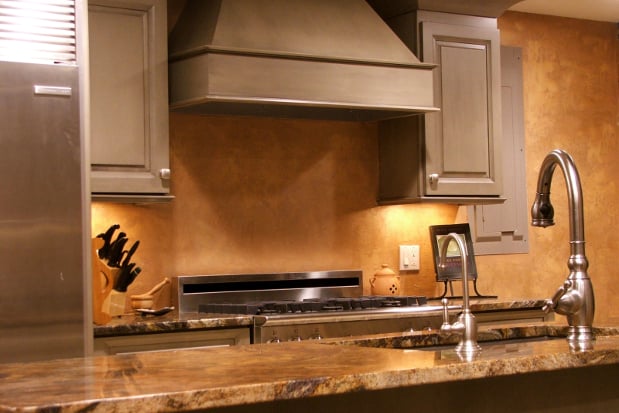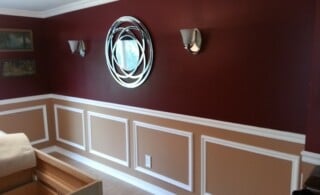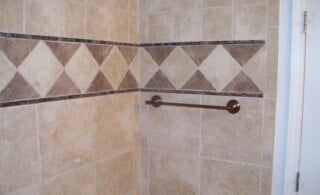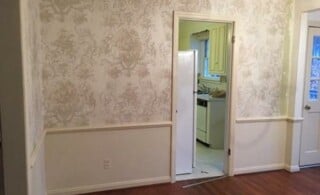
Drywall is, by far, the most common wall in homes today. With the advent of drywall, homeowners quickly began choosing this less expensive and easily repaired wall material. Plaster, however, is making a solid comeback. Improved plastering techniques and plaster veneers are making it more affordable again with many of the former benefits still in tact. Venetian plaster walls are thicker and more durable than their drywall counterparts. They receive paint more uniformly, and their additional strength makes it easier to strip wallpaper without damaging the wall. Plaster also has a short-term resistance to water, unlike drywall. More than structural superiority, plaster creates a flatter, smoother surface.
Real and Faux Venetian Plaster Walls
Real Venetian plaster walls are still uncommon in today’s residential homes. This type uses a mixture of marble dust and other materials to create walls of unmatched strength and beauty. However, it requires a highly trained craftsman and is not at all cheap. In fact, real Venetian plaster is most commonly used not as interior walls, but as a cheap alternative to marble. While the texture of real plaster can be achieved with a veneer, it will take quite a skilled artisan with a decorative painting technique to fully imitate the color of the real thing. That said, even a veneer is going to blow your neighbor’s walls out of the water.
Ready to start your Plaster Project?
Find ProsWhile priced competitively with drywall, faux plaster requires more expertise than most homeowners possess to install. You’ll probably need some specific experience handling plaster, as a general “handiness” isn’t enough to produce the striking effect of Venetian plaster installation. The base for faux plaster is usually gypsum-based lath paneling. A thin layer of plaster is then applied over the paneling with a trowel to create the desired effect. After that, a decorative paint is applied to the veneer to create your wall finishing.
Venetian Plaster Repair
Though plaster is considerably stronger than drywall, it’s not indestructible. Cracked or damaged walls are not uncommon, especially in older homes that have plaster from several decades ago. There are essentially two routes to take when considering Venetian plaster repair. First, you can hire a professional to come in and re-apply plaster to the cracks. This will help re-create the strength of the original plaster walls. You can also hire a drywall company that will be able to give you a passable plaster repair with substitute materials, including (but not limited to) drywall itself. These substitutes are a good imitation if the entire wall is resurfaced to blend the repairs together with the original walls. In fact, you can even attempt a DIY plaster repair, but you’ll need to be super prepared for this kind of resurfacing unless you’re willing to live with visible inconsistencies in your wall. Keep in mind that this wall resurfacing is generally still cheaper than hiring someone to repair the cracks with more plaster.
Venetian Plaster Installation and Decorating
Obviously, Venetian plaster installation is easiest done during the initial construction of your home. If your home has experienced extensive water damage that severely comprised your drywall, this might also be an excuse to upgrade your home with an extra treat. But for most homeowners, the idea of ripping down all of the interior walls and starting from scratch isn’t a very persuasive one. That said, there’s no reason you can’t mix and match. Just as you might create an accent wall with a different tint or shade of interior paint, you can install plaster on one of your walls. One of the most popular ideas, with truly breathtaking results, is to install a plaster wall as part of your fireplace surrounds.
 Decorative Moldings: The Perfect Cover-up
Decorative Moldings: The Perfect Cover-up  Wood Veneer: An Upside to Being Shallow
Wood Veneer: An Upside to Being Shallow  Ceiling Mirrors – Considerations, Types & Options
Ceiling Mirrors – Considerations, Types & Options  The Basics of Ceramic Wall Tile Installation
The Basics of Ceramic Wall Tile Installation  Wallpaper Prep
Wallpaper Prep 

You are wrong when you say plaster can be fixed with drywall materials!! Every drywall contractor thinks he/she can repair plaster. I am a master Plasterer and they are two totally different trades. I also do Italian and Venetian plasters and yes, they are coming back. But leading people down the wrong path with repairing plaster is wrong! It will not hold up and the cracks will come back with drywall materials!
I have been looking at different options for plaster and I have never heard of venetian plaster walls before. That is great that they are thicker and more durable than drywall. I didn’t know that it has a short-term resistance to water as well. That would be really nice incase something were to happen, like a flood or heavy rainfall and it got into the house. I will have to look more into that option! Thanks for the information!
Venetian Plaster performs well in wet climates and humidity, while providing a natural resistance to mold because it’s based on the natural minerals of lime and marble.
Venetian plaster in its traditional form is an all natural material and does perform well in humid environments.
Rebekah is correct in that you cannot use drywall or gypsum plaster to make a good repair of venetian plaster. Traditional venetian plaster is traditionally made out of lime and comes in various grain sizes. The important part to making venetian plaster repair is to identify the correct material (lime or acrylic) and grain size (smooth and glossy, small grain, or course grain) and then to color match against the dried plaster. Once that is done the work can start. It is done in 2 to 3 coats and needs to finish smooth and level to the surrounding plaster. If it is raised higher than the surrounding it will leave a hot spot. And always, use a stainless steel trowel. It is a difficult job to do perfectly, and there are actually very few professionals that can make the repair perfectly.
Typically we are applying Venetian plaster on an interior wall that was built with standard drywall and lightly textured with an “orange peel” texture. We roll on an acrylic/lime/marble or acrylic/lime/sand primer and after a day or so we begin to apply coats of Venetian plaster via special stainless steel trowels. We are speaking here of true lime/marble Venetian plaster which may contain natural clays and soap binders, not synthetic/fake Venetian plaster that is not lime-rich.
After a first coat has dried a day or so, we mist the surface and also possibly lightly wet-sand and proceed to apply a second coat. The artisan may complete the final coats on this day or come back another day and apply yet further coats but at some point for the final burnished/polish coats the artisan has a small time window (could be 15 minutes, 30 minutes, etc.) to burnish/polish the plaster just as it shows signs of drying (will lighten up).
In another scenario, we apply these fine lime/marble plaster veneers over standard Portland cement-based concrete. In yet another scenario, we apply these fine lime/marble plaster veneers over thicker lime-based plaster/masonry coats that may even feature larger pieces on limestone, sand, etc. Whether a flat/unburnished/unpolished look or a high-sheen/burnished/polished look, these plasters provide new dimensions of warmth, harmony and beauty to the home.
There are a world of possibilities with lime-based plasters and other coatings and the beauty is beyond compare. As stated by Rebekah and Mathew, drywall mud should not be used to attempt a Venetian plaster repair… this work should be done by an experience Venetian plaster artisan. Color matching for repairs is best guided by the original formulas of the plaster provider and artisan. Some fresco techniques may also be expertly deployed during some patching processes. Venetian plaster is very maintainable and you can accomplish a color and/or style change anytime, just make sure to hire an experienced specialty Venetian plaster artisan or learn the art and do it yourself.